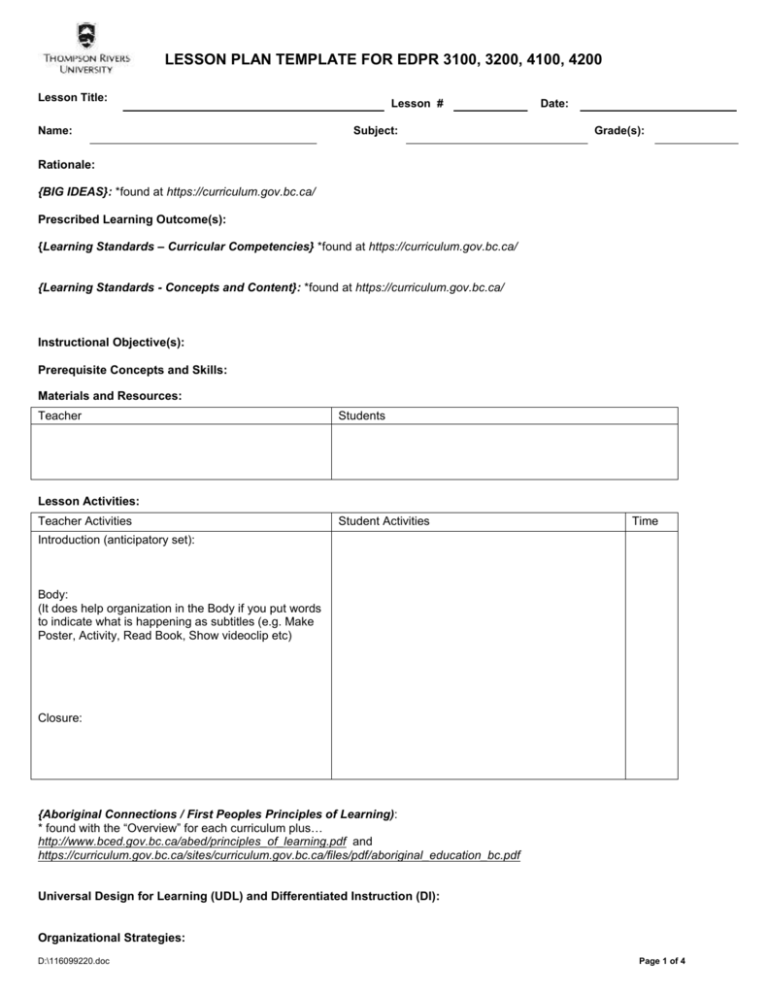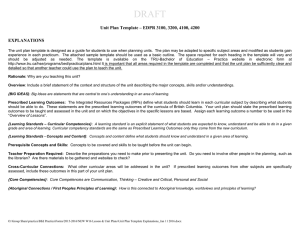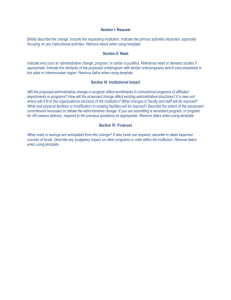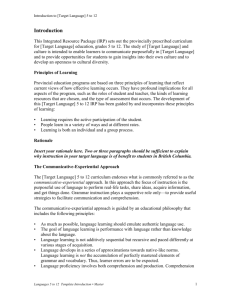Sample Lesson Plan Template
advertisement

LESSON PLAN TEMPLATE FOR EDPR 3100, 3200, 4100, 4200
Lesson Title:
Name:
Lesson #
Subject:
Date:
Grade(s):
Rationale:
{BIG IDEAS}: *found at https://curriculum.gov.bc.ca/
Prescribed Learning Outcome(s):
{Learning Standards – Curricular Competencies} *found at https://curriculum.gov.bc.ca/
{Learning Standards - Concepts and Content}: *found at https://curriculum.gov.bc.ca/
Instructional Objective(s):
Prerequisite Concepts and Skills:
Materials and Resources:
Teacher
Students
Lesson Activities:
Teacher Activities
Student Activities
Time
Introduction (anticipatory set):
Body:
(It does help organization in the Body if you put words
to indicate what is happening as subtitles (e.g. Make
Poster, Activity, Read Book, Show videoclip etc)
Closure:
{Aboriginal Connections / First Peoples Principles of Learning):
* found with the “Overview” for each curriculum plus…
http://www.bced.gov.bc.ca/abed/principles_of_learning.pdf and
https://curriculum.gov.bc.ca/sites/curriculum.gov.bc.ca/files/pdf/aboriginal_education_bc.pdf
Universal Design for Learning (UDL) and Differentiated Instruction (DI):
Organizational Strategies:
D:\116099220.doc
Page 1 of 4
Behavioural Management Strategies:
Assessment and Evaluation:
Extensions:
Reflections (if necessary, continue on separate sheet):
D:\116099220.doc
Page 2 of 4
Lesson Plan Template – EDPR 3100, 3200, 4100, 4200
The lesson plan template is designed as a guide for students to use when planning lessons. The plan may be adapted to specific
subject areas and modified as students gain experience in each practicum. The template is a basic outline that can be used
directly as printed, copied in longhand, or expanded from the electronic version. It is important that all areas required in the
template are completed and that the lesson plan be sufficiently clear and detailed so that another teacher could use the plan to
teach the lesson.
The Lesson Plan template is currently under revision to reflect the new BC curriculum that will be in place in the next
year. Any area that is in brackets { } denotes a recognized area from the new curriculum
Rationale: Why are you teaching this particular lesson at this time? (e.g. is it part of a complex skill? Is it an essential prereading
skill in reading? Is it important that the students hear good literature?) What is the significance of the area of learning to students?
{BIG IDEAS}: Big Ideas are statements that are central to one’s understanding in an area of learning.
Prescribed Learning Outcomes: The Integrated Resources Packages (IRPs) describe what students should be able to do in
each curricular subject. Your lesson should state one or more prescribed learning outcomes, from the curricula of British
Columbia, on which the objectives of this specific lesson are based.
{Learning Standards – Curricular Competencies}: A learning standard is an explicit statement of what students are expected to
know, understand and be able to do in a given grade and area of learning. Curricular competency standards are the same as
Prescribed Learning Outcomes only they come from the new curriculum.
{Learning Standards - Concepts and Content}: Concepts and content define what students should know and understand in a
given area of learning.
Instructional Objective(s): What are the specific things students will be able to do as a result of this lesson? These objectives
should be consistent with your stated prescribed learning outcome(s) (e.g. the students will be able to identify the main idea in the
story. The student will be able to describe the main idea in a paragraph of four sentences). The objectives may also include things
the teacher wants to observe in the course of the lesson (e.g. to identify the potential leaders in group discussion). Students
should ensure that the instructional objectives are measured by your assessment and evaluation strategies.
Prerequisite Concepts and Skills: This section of your lesson plan is used to state the concepts and skills needed to connect
lessons together in a logical sequence, building new knowledge onto what you know students have previously learned. Remember
that some concepts and skills may need to be reviewed to ensure continuous learning, and these can be included here.
Materials and Resources: List all materials and resources that you and the students will need. What things do you need to do
before the lesson begins? (e.g. prepare a word chart.) What things do the students need to do? (e.g. read a chapter in the novel.)
Lesson Activities
Introduction: How will you get students interested in the topic? How will you find out what they already know about the topic?
Will you use an anticipatory set (link to their experience) or advance organizers?
Body: What sequence of activities will the student experience? What will you do? What will they do? What will children do who
finish early? How much time will each activity take? What about clean up? In the Body, It is helpful for organization if you put in
subtitles to indicate a change in activity. E.g. . Make Poster, Activity, Read Book, Show videoclip etc
Closure: How will you close the lesson? The closing should be linked to attaining your instructional objectives.
Universal Design for Learning (UDL) and Differentiated Instruction (DI): UDL includes: Multiple means of representation;
Multiple means of expression; and, Multiple means of engagement. DI is the process of ensuring that a student’s readiness level,
interests, and preferred mode of learning are recognized. Teachers can differentiate instruction in four ways: content, process,
product, and, learning environment based on the individual learner.
How will you accommodate your diverse learners? What are the individual needs within this classroom and how will you
accommodate them? Consider learning styles, multiple intelligences, Aboriginal and cultural influences. What are the adaptations
and modifications needed for students with Individual Education Plans (IEPs)?
{Aboriginal Connections / First Peoples Principles of Learning}: How is this connected to Aboriginal knowledge, worldviews
and principles of learning?
Organizational Strategies: Carefully thought-out organizational management strategies facilitate proactive positive classroom
management. For example, how will you : bring the class together at the start of the day/lesson?; utilize student helpers to
D:\116099220.doc
Page 3 of 4
facilitate the flow of lessons and the day in general?; distribute and collect materials?; separate the class into groups or levels? (In
what situations should groups be assigned ahead of time?); coordinate different grade levels working on different assignments?
Behaviour Management Strategies: Carefully thought-out behaviour management strategies facilitate proactive positive
classroom management. What strategies will be used?
Assessment and Evaluation: Did the students learn what you taught them? The results of the assessment should be directly
related to, and tell you if, your students were able to do the things outlined in your instructional objectives and prescribed learning
outcomes, {learning standards}. Your assessment should be as accurate as possible and should be built into your lesson. What
rubrics or structures will you use to evaluate assessment data? Is assessment formative or summative? Include the assessment
tool. Are you using assessment for, of or as learning?
Extensions: How might this lesson link to previous and/or future lessons within the same curriculum area? How might knowledge,
skills or attitudes from this lesson be integrated/infused into lessons in other subject areas?
Reflections: Complete the reflections section as soon as possible after teaching the lesson. What revisions would you make to
the lesson? What went well?
D:\116099220.doc
Page 4 of 4




![Lesson Plan Template: Teacher Facilitated Literacy [doc]](http://s3.studylib.net/store/data/006681424_1-f242ece395a51b1c33fbc141f61f3ce4-300x300.png)




